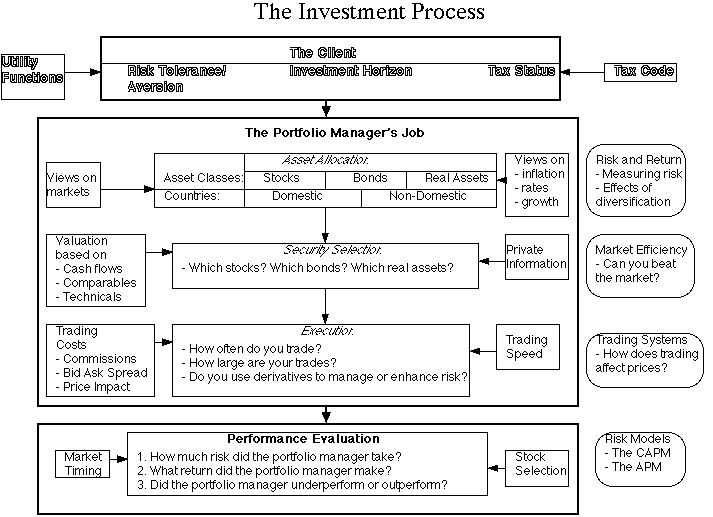Understanding the Client
The investment process starts with the investor, and his or her needs and preferences. To design the "right" portfolio for an investor, we need to understand how much risk he or she is willing to take, what his or her cash needs might be and the tax status of the investor.
The first and most critical component of this part of the process is the risk assessment part. The willingness and the capacity to bear risk varies widely across investors, and the portfolio should reflect this risk preference. Most people would agree with the basic concept that in order to earn a higher return an investor has to be willing to take more risk. To assess risk accurately, however, we need to define risk, and this is where the consensus breaks down. In portfolio theory, risk is generally measured as the deviation of actual returns from expected returns. In addition, while there are several competing financial models of risk, they all share the common view that it is only the risk that an investment adds on to a diversified portfolio that is rewarded and not the total risk associated with the investment. While this statistical derivation of risk is convenient from the standpoint of developing portfolio theory, it is unlikely that even the most sophisticated of investors thinks of risk in these terms. Most investors think about risk in much more intuitive terms - the likelihood of losing money on an investment, the worst case return ... Part of the task of a portfolio manager or investor is to convert these intuitive measures of risk into statistical measures for use in portfolio design.
The second component of this part of the process is an understanding of the cash needs of the investor. An investor who needs to withdraw cash on a regular basis from a portfolio will have a very different portfolio that one who does not expect to make these withdrawals or one who expects to add cash to the portfolio over time. In a sense, this provides a measure of the time horizon of the investor, with significant cash withdrawal needs shortening the expected time horizon for the portfolio.
The third component is the tax status of the investor. Investors vary widely in terms of the tax liabilities that they face, especially when we consider institutional investors in the mix. At one extreme are pension funds that pay no taxes, while at the other are wealthy individual investors who with federal, state and local taxes have high marginal tax rates. Add to this mix the complexities of the tax code, including the difference in tax rates between capital gains and ordinary income, potential tax deductions and estate taxes, and it becomes quite clear that portfolio decisions cannot be made without an understanding of the tax code. Having said that, a portfolio should never be constructed purely for the purpose of minimizing tax liabilities is likely to be an inferior portfolio. The objective in portfolio management is to construct the best possible portfolio for an investor, given his or her tax liabilities and cash needs, with the objective of maximizing the after-tax returns over time to that investor.

